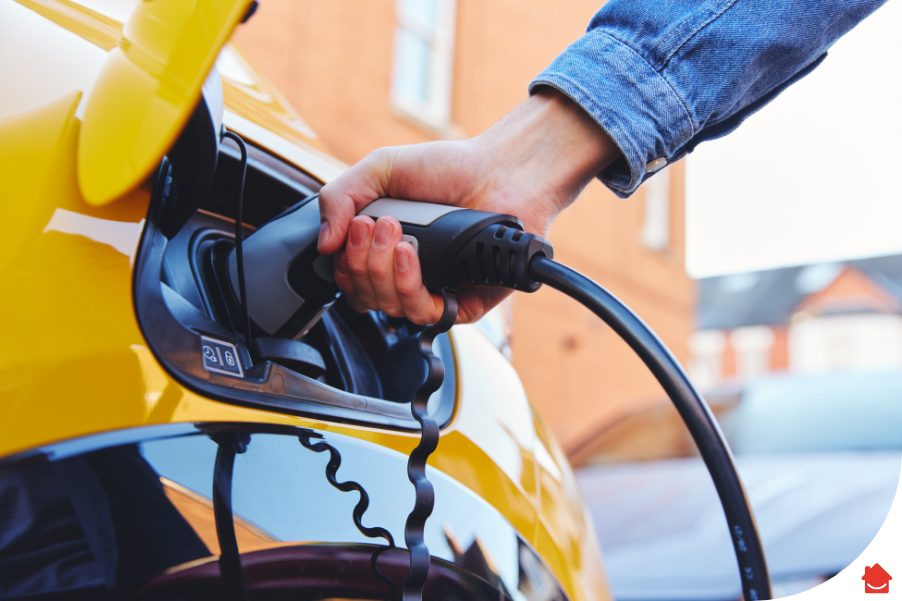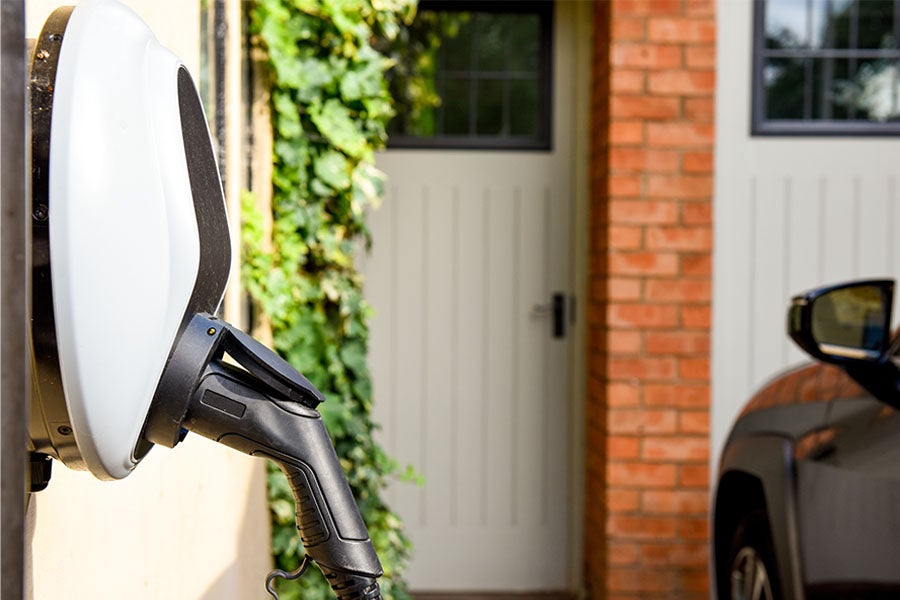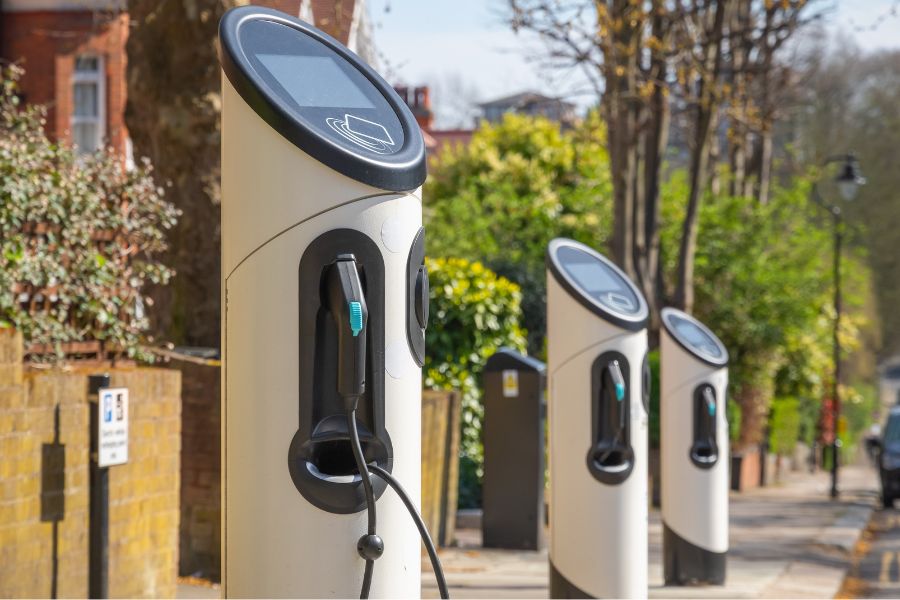Energy saving advice
Charging an electric car: The complete guide
22 May 2025 • 5 minutes

Energy saving advice
22 May 2025 • 5 minutes

Understanding the different types of EV chargers and connectors is key to making the most of your EV charging experience. You may be surprised by what you learn...
Level 1 chargers use a standard 120V household outlet, making them the easiest option to start with. However, they charge slowly, typically adding 3-5 miles of range per hour. This method is ideal for overnight charging if you have low daily mileage or drive a plug-in hybrid.
Level 2 chargers use a 240V circuit, similar to what powers appliances like dryers. These chargers are much faster, adding 12-30 miles of range per hour, making them the most popular option for home charging.
DC fast chargers are found at public stations and can charge your EV quickly, adding 60-100 miles of range in 20-30 minutes. These chargers are ideal for long trips or quick top-ups but are not typically used for home charging due to their high power requirements.
Ultra-rapid chargers are the fastest option, offering charging speeds of 100kW to 350kW. These can charge an EV up to 80% in around 20 minutes. They are mainly available at high-traffic public charging points and are designed for quick refuelling on long journeys.
Type 1 connectors are common in North America and are used for both Level 1 and Level 2 charging. This connector is found mostly in older vehicles.
Type 2 connectors are standard in Europe and are used for both Level 2 and AC fast charging. Most modern EVs in Europe are compatible with this connector.
CHAdeMO is a fast-charging connector used primarily by Japanese vehicles. It also supports bi-directional charging, allowing for vehicle-to-grid functionality.
CCS connectors come in two types: CCS1 for North America and CCS2 for Europe. This system combines AC and DC charging in one plug, making it highly versatile. It’s widely supported by most modern EVs.
There are a few different ways in which you can charge an electric car, with each one slightly varying when it comes to things like charging speeds.
The easiest and safest way to charge your car is to park it off-road—either in your garage or your driveway. It’s possible to charge your car when it’s parked on the road, but we’d suggest you check with your council first, as running your charging cable across the pavement could be a safety issue for pedestrians. You’ll also need to make sure your cable will be long enough to comfortably reach your car.
Next, decide the best place to install your charging point. Again, keep safety in mind – if your charger is attached to the back wall of your house and you need to run the charging cable around the side to the front, there’s more chance someone will trip over it!

Charging your electric car at home is simple and hassle-free. You can use a regular household outlet for slower charging or install a faster charger with the help of a professional.
Once it’s installed, all you need to do is plug in your car and it will start charging automatically. Most cars even let you track the progress on a screen or an app.
You can even charge your electric car overnight—saving money by doing so during off-peak hours. Just make sure your charger is safely set up, and when you’re done, neatly store the cable. If you have a garage or sheltered spot, that’s perfect for keeping your charger safe from the weather!

Charging your electric car in public is easy and convenient, especially with so many charging stations available. You can find public chargers by typing in “electric car charger” into Google, or even through your car’s navigation system—which often shows nearby stations.
Once you arrive at a station simply park, plug in, and follow any instructions on the charger’s screen or app. Many public chargers offer faster charging than home setups, so you can quickly top up while running errands or during a trip. Be sure to check whether the station requires payment or offers free charging, and remember to unplug and move your car when charging is complete to keep the spot available for others!
Don’t try and do it yourself! Home EV charging points must be installed by a certified installer. A quote from a certified provider will include the installation cost and fitting the charger itself will generally take about three hours to complete.
The “smart” part of a smart charger is that you can use an app to monitor how your car is charging and also set a timer for when you want the charger to switch on. This would definitely come in handy if your electricity is cheaper at night: you could plug your car in when you get home from work, but set it to come on in the middle of the night.
It’s also worth noting that from 1st July 2022 non-smart charges are banned in the UK. This means all charge points will need to have data connectivity, making them smart to varying degrees.
Yes you can, but it isn’t advised as a permanent solution to your charging needs – this is because your standard 3-pin plug isn’t designed to facilitate such high levels of power over time and it could take you much longer than a purposely designed charging point.
Yes, it is possible to use a 13 amp socket, but it will be much slower than if you use an EV charging point. It’s generally not advised to use a normal plug socket, but it is possible as a temporary measure if there are no other charging points available.
You don’t need planning permission to install your charger, but the tradesperson installing your charger will need to inform the district electric network supply company. This doesn’t stop charger installation at the moment, but it could do so in the future if regulations change.
Your charging point will run off your mains electricity supply and is usually either 3.6kW or 7kW. Some cars can charge up to 11kW, but these need to be using a 3-phase connector via your electricity supply and most homes only use a 1-phase connector. If you aren’t sure which connector you have or want to use an 11kW charger, please contact your electricity provider for help.
Ready to power up your electric vehicle from the comfort of home? We’ve teamed up with BOXT to provide EV charging installation that ensures fast, safe, and efficient charging every time.
With professional installation, you'll enjoy the convenience of having your car fully charged whenever you need it.
Our help & advice articles cover Plumbing, Home heating, Electrical, Energy-saving and Home maintenance.